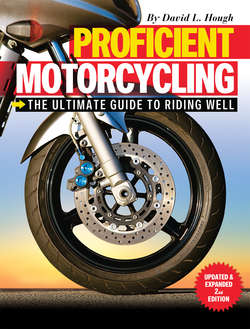Читать книгу Proficient Motorcycling - David L. Hough - Страница 58
На сайте Литреса книга снята с продажи.
U-Turns
ОглавлениеIf you’re paranoid about slow speed U-turns, you’re not alone. Heavyweight machines can be a handful at slow speeds and in tight quarters. The novice technique is to drag the foot skids, turn the bars to the stop, and feather the clutch to creep around. The novice may also discover that the bike has a larger turning diameter than the space available (often discovered just as the front tire threatens to drop off the pavement onto a loose gravel shoulder).
Scott Wilson demonstrates a tight turn. Note that he is slipping the clutch to keep the engine pulling. He has shifted his weight to the outside of the saddle and is looking where he wants to go, not down at the pavement in front of the bike.
The trick for tight U-turns is being aware that as the bike is leaned over farther, it will make a tighter turn. So rather than drag your boots on the ground with the bike vertical, what’s needed is to lean the bike over to a steeper angle.
The technique is to place most of your weight on the outside, lean the bike wa-a-a-y over, and keep the engine pulling. It’s OK to slip the clutch if needed to keep the engine from stalling, but squeezing the clutch in a tight turn is usually followed by the sound of a bike hitting the ground. Don’t try to coast around a tight turn; you need to keep the engine pulling to balance centrifugal force against gravity. In tight turns, it helps to swivel your head around like a barn owl and look where you want to go. Staring at the ground three feet ahead of the bike may result in finding yourself on the ground right where you were looking.
If the bike seems to go wider than you want it to, you need to lean it over farther. Shift your weight to the outside edge of the saddle or stand more on the outside foot peg. Grab those grips and push the bike over. To avoid any confusion over whether you are pulling or pushing on the low grip, imagine pushing both grips toward the turn to lean the bike over more and pushing both grips away from the turn to keep it from falling over or to straighten up. By now it should be obvious that we are using direct steering most of the time and brief countersteering adjustments to help control lean angle.
